Watch this space – 2023 in spaceflight – Royal Aeronautical Society
The past 12 months have been an historic year in space exploration, but what’s on the horizon for 2023? RICHARD LOWE offers some insight.
The past year has shone a spotlight on the importance of space in global affairs.
The role of space in climate monitoring – providing evidence for both climatic changes and the pollution that causes them – is now well established. The COP27 summit in Egypt drew upon multi-decadal observing records that span the globe and only satellites can provide such data at truly planetary scale.
This year also very publicly demonstrated the tactical and strategic value of space to warfare. Coverage of the Russian invasion of Ukraine routinely refers to satellite communications systems (such as SpaceX’s Starlink)[1], satellite navigation systems (such as GPS) and satellite observing systems (such as Iceye’s and Maxar’s).
These capabilities have helped to level a playing field that was hugely tilted in Russia’s favour. The present situation in Ukraine, as of January 2023, would be very different if Ukraine had not benefited from the tactical communication, precision guidance and strategic situational awareness that space is delivering. In a conflict where neither side can control the air, satellites are still able to track mechanised deployments, assess battle damage and provide evidence of war crimes.
Of course, the war has had a wider impact on the space sector itself too. The role of Russian launch services has likely been permanently diminished; Europe’s ExoMars lander mission has been postponed (including the UK-built Rosalind Franklin Mars Rover); and the decades-long partnership of the International Space Station now looks set to end.
History in the making

Engine test of SpaceX Starship, which is set to make its first flight in 2023. (SpaceX).
It’s not all adversity though. The James Webb Space Telescope is now earning its place as Hubble’s successor, providing incredible images of the cosmos.
NASA’s Artemis 1 moon rocket also made its debut flight and China completed its own space station, Tiangong. Elsewhere in the solar system, it’s heart-warming to note that the little helicopter known as ‘Ginny’ (Ingenuity) continues its flying adventures on Mars.
The maiden flight of Orbex’s Prime launcher from Sutherland – potentially in 2023 – will mark a milestone as the first vertical UK launch, with an indigenous UK launcher. At that point, the UK can more legitimately claim to have its own sovereign access to space.
On the launchpad for 2023
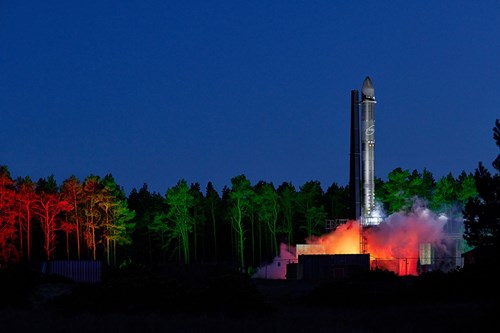
The maiden flight of Orbex’s Prime launcher will mark a further milestone as the first vertical UK launch, with an indigenous UK launcher. (Orbex)
Personal adventure is fast becoming the primary driver of human spaceflight. Want to visit space? Form an orderly queue!
Blue Origin has now conducted six crewed sub-orbital flights. Each new mission takes six passengers to the edge of space. It has not all be plain sailing though and a recent launch of New Shepard [September 2022] failed. Thankfully, it was an uncrewed launch carrying experiments – and it’s also reassuring that the emergency capsule ejection system worked as planned. On detection of a thrust anomaly, the capsule was ejected and returned safely to the ground. It’s hard to predict if events like this will boost or reduce confidence of paying passengers. Spaceflight remains an adrenaline sport.
This year, Boeing intends to finally achieve crewed flight to the ISS for its long-delayed Starliner capsule. Meanwhile, SpaceX – so often a step ahead – aims to fly a private crew of funders and artists all the way around the Moon as well as taking tourists to the ISS and doing the first commercial spacewalk.
Following a successful first flight, the US’ Space Launch System (SLS) will now go on to enable the planned Lunar Gateway station, in orbit above the Moon. The Orion spacecraft carried into space as SLS’s payload (and like its launcher, very much over budget and behind schedule) contains a service module supplied by the European Space Agency, representing Europe’s down payment for one of its astronauts to walk on the Moon this decade.
A new three-man crew was scheduled to take over the Chinese Tiangong space station in December 2022, following its tripling in size earlier in the year with the addition of two 20-ton modules offering extensive microgravity research facilities. At the end of 2023 the station is expected to be enhanced once more with the launch of the Hubble-class Xuntian space telescope that will undertake sky surveys and will occasionally dock with the station.
ESA’s latest astronaut intake has been announced and includes three UK citizens – an astronomer, a scientist and an Olympic athlete. They join 14 other newly appointed European astronauts.
Solar System
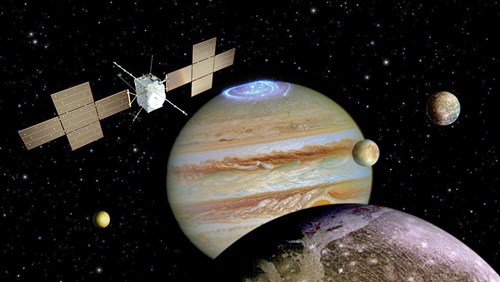
ESA’s JUICE is expected to be the big science launch for 2023. It will ultimately enter orbit around Jupiter’s moon Ganymede. (ESA)
ESA’s JUpiter ICy moons Explorer (JUICE) is the big science launch for 2023. Really significant solar system exploration missions don’t come along very often, but JUICE must qualify. Its 12-year mission is to boldly go where no mission has gone before, entering orbit around Jupiter’s moon Ganymede. No previous spacecraft has ever orbited a moon other than ours. Every time a mission has visited a new place in the solar system, the results have been a surprise.
The icy moons of Jupiter are particularly promising destinations. Ganymede is an extraordinary place by any measure. Larger than Mercury but only half its mass, it is the only moon known to have a magnetic field (resulting from a metal core). It’s also predicted to host a global salt-water ocean under its thick, ridged ice layer, containing more liquid water than all Earth’s oceans.
JUICE will also study Ganymede’s icy neighbours, Callisto and Europa – both of which undoubtedly harbour further surprises. It will take eight years to reach its destination, with various fly-bys on the way.
Elsewhere, a host of missions continue their long and winding paths – including BepiColombo (ESA, Mercury); Solar Orbiter (ESA, Sun) and Parker Solar Probe (NASA, Sun). Each will provide postcards from time to time, as they edge closer to their final orbits in the inner solar system.
In the other direction, the New Horizons probe speeds out far beyond Pluto – unlikely to ever encounter another body but still transmitting.
Launch highlights
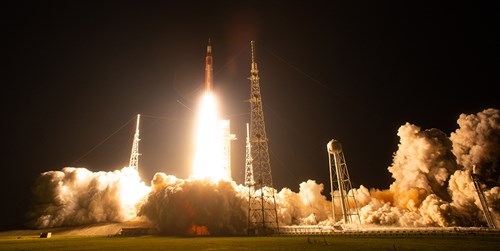
NASA’s Space Launch System rocket carrying the Orion spacecraft launches on the Artemis I flight test on 16 November. (NASA)
Launches are now reaching record levels. In 2022, just over 150 launches took place and this year will be just as busy.
SpaceX performed as many launches as China (both just over 50) – and represented over 2/3 of all US launch attempts (77) [3]. Impressively, 47 of SpaceX’s Falcon 9 launches re-used hardware from earlier launches. By comparison, Europe’s three launches (four if including a Soyuz from Kourou) look quite meagre. Astonishingly, the UK may soon be in a position to overtake the rest of the EU in launch cadence.
SpaceX’s Starship may already have had its maiden flight by the time you are reading this. The super-heavy launcher is designed for full reusability – which would be a first for any launch system. It’s also designed to put more than 100 tonnes into low earth orbit, in one shot. That kind of lifting power has not been seen since the days of the Apollo programme and Saturn V.
Nevertheless, it won’t be alone. The US also now has the Space Launch System (SLS), which successfully launched in November 2022 – but SLS is not reusable so the economics could stack up very differently. This will be a pivotal time for the economics of spaceflight. The sheer scale of what Starship (and SLS) can do may unlock entirely new satellite paradigms – if entrepreneurs have the vision and the finance to pursue them. The entire mass of the ISS could be lifted in four flights – but the techniques to assemble large scale structures in orbit remain in their infancy.
Europe’s long-awaited Ariane 6 might make its debut flight in 2023. While it will help to sustain and improve European heavy-lift capability, it’s unlikely to worry SpaceX. Ariane 6 represents a relatively incremental improvement over earlier generations and remains a single-use launcher. Nevertheless, it has secured an orderbook of customers and meets a need – giving France and the wider EU assured, independent access to space beyond Low Earth Orbit. Programmes such as Galileo (European Navigation system), the MeteoSat series (atmospheric observation), various communication systems and ESA’s solar system exploration will all make use of it. Just as SpaceX is underpinned by the US space programme, so too is ArianeSpace by Europe’s.
Blue Origin’s New Glenn launcher might also make a flight in 2023. Both New Glenn and Ariane 6 are tentatively scheduled for the last quarter of the year.
Earth observation
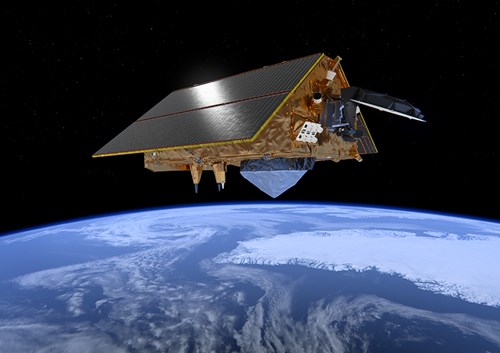
EUMETSAT’s satellites collect weather and atmospheric data to monitor climate change. (ESA)
ESA’s long-running series of ‘Earth Explorer’ missions is going through a quiet patch until 2024, when several missions will likely come close together (BIOMASS, EarthCARE, then FLEX in 2025).
Nevertheless, Europe’s Earth Observation (EO) community will benefit from new data from EUMETSAT’s MeteoSat third generation satellites from late 2022 onwards. EUMETSAT manages a fleet of spacecraft whose primary purpose is to collect weather and atmospheric data. That data plays a crucial role in supporting disaster responses, improving weather forecasting and enabling global climate modelling. The new missions will include both imagers and ‘sounders’, designed to measure temperature and humidity throughout the atmosphere. The new measurement sets will fill in gaps in ground-based observations, improving the skill with which forecasts can be made.
Satellite navigation
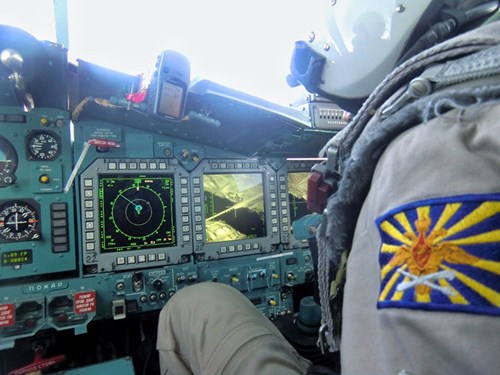
Garmin GPS unit mounted on cockpit combing on Russian Su-34 over Syria. (Russian Internet)
The events unfolding in Ukraine are going to provide case studies in defence and critical national infrastructure (CNI) for many years to come. The war is a thankfully rare case of hot conflict between opposing forces with substantial electronic warfare capability. Both sides appear to be using GPS for their own ends [4] (and likely, a mix of Galileo and GLONASS too). It’s very likely that both sides are also deploying signal jamming and spoofing to undermine their opponents… as well as anti-radiation missiles to knock out transmitters (including jammers, radar and communications).
Despite the severely contested signals environment, Ukraine’s armed forces continue to function – and to use weapons systems that reach their targets at long range. The same is true for Russia. Satellite navigation is evidently still enabling uncrewed air and naval systems, as well as precision artillery and rockets. In recent years, there has been considerable attention paid to improving the resilience of such systems in the face of electronic countermeasures. Perhaps that effort is paying off? There are many ways to navigate – and improvements continue in systems such as inertial guidance, visual and radar systems. ‘Sensor fusion’ (combining data from multiple sensors) can fill the gap when GPS drops out or a camera loses line of sight.
The year ahead will not see major new capabilities in satellite navigation – but what’s happening right now may have a substantial impact on the future evolution of timing and navigation services for CNI and defence.
Following Brexit, the UK government continues to very slowly ponder its path for a national position, navigation and timing (PNT) capability. There will be lessons to learn from Eastern Europe.
In-Orbit Service & Manufacture

ESA has selected Britain’s Rosemary Coogan, John McFall and Meganne Christian as part of its latest astronaut intake. (UK Government)
Finally, a sector to keep an eye on! Here on Earth, industry depends on utility providers, waste disposal services and logistics operators. As the scale and ambition of space systems grows, the same will be true in orbit. Services are now forming to offer debris removal, in-orbit refuelling, construction, transport between orbits and even repairs.
It’s unlikely that these innovative companies will have their big break-through in 2023; after all, their business inherently depends on serving the ambitions of others. Nevertheless, new launchers and new technology make big dreams possible.
An industrial estate in space might seem to be sci-fi but 15 years ago, private space tourism seemed a little far-fetched. It’s here.
Postscript
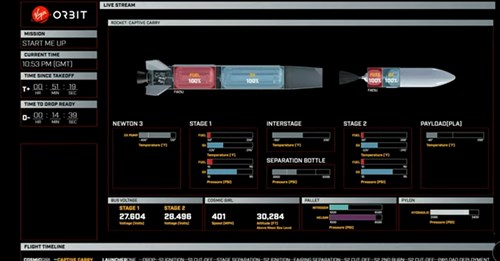
Telemetry from the ill-fated LauncherOne (Virgin Orbit)
On the night of 9 January 2023, Virgin Orbit attempted the first ever orbital launch from the UK, out of Spaceport Cornwall at Newquay airport. The ‘Start Me Up’ mission was carrying a range of payloads under the wing of a modified Boeing 747 called ‘Cosmic Girl’.
News of the launch’s failure is a setback for UK launch in general, but a serious blow for the businesses who’s plans depended on it (VO included). LauncherOne had made four successful flights prior to this first attempt away from their home ground in Mojave, US. The original June 2022 target UK launch date gradually slid back throughout the year as all the elements necessary for national launch coordination came together.
All the organisations involved will now be looking to contain the impact and ensure a path to recovery.
From a national perspective, despite the night’s losses, the attempt has genuinely brought the UK closer to being a ‘launching nation’. It has been the combined work of the spaceport, the CAA, the UK Space Agency, international air traffic management, the MoD and, most centrally, the launch customers and suppliers. Getting to launch day represents a major organisational achievement, much of which will go on to underpin future UK launches – not just from Cornwall but also from the sites in Scotland, as they prepare for vertical launches later this year.
As on so many occasions, “per ardua ad astra” captures something of the moment.
1 OneWeb is scheduled to complete its own communication constellation in 2023
3 https://en.wikipedia.org/wiki/2022_in_spaceflight#By_country
4 Including anecdotal reports of Russian pilots strapping GPS receivers into their cockpits






